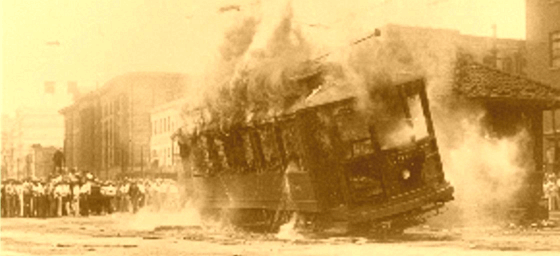|
Today in New Orleans History |
|
|
July 1



 

To receive an update for each day in New Orleans
history, join our facebook page
- Today in New Orleans History
Tweet
In December 2005 the Tulane University board of directors announced that the university would be
reorganized on July 1, 2006, to accommodate needed changes due to losses following Hurricane Katrina. The
board also approved the recommendation of a special Tulane Renewal task force to name a revised, co-educational, single undergraduate
college -- Newcomb-Tulane College. The new college within the university is not strictly a successor to Newcomb College. Arguing
the "renewal" plan violated the donor's original intention of the gift, Newcomb's heirs filed and lost two suits
against the university to invoke the restrictions of Newcomb's lifetime gifts and bequest in her will. The university stated
that by naming Tulane her universal legatee in her will, Josephine Louise Newcomb placed no conditions on the use of her
donations, but entrusted her gifts to the discretion of the Administrators of Tulane University. In 2008 Susan Henderson
Montgomery, a great niece of Josephine Louise Newcomb and the plaintiff claiming to be her successor, after losing in New
Orleans civil district court, appealed to the state. On October 13, 2010, a state appeals court sided 3-2 with Tulane University.
On February 18, 2011, the Louisiana Supreme Court voted, 4 to 2, with one abstention, to let a lower court's ruling in favor
of Tulane stand.
According to Buddy Stall at http://clarionherald.org/20000831/stall.htm: On July 1, 1925, brothers
Sam and Emanuel Pulitzer, ages 20 and 22 respectively, decided to team up and make their mark
in the business world. With very little formal education, less experience and even less money ($300), they formed the Pulitzer
Brothers Neckwear Company. The basis of their entering this line of business was that Emanuel
had worked in New York and had gained some expertise in the sale of neck ties. Although their business experience was nil, they both had learned from their parents the importance of hard work tempered with scheduled time for relaxation. In 1925 bow ties were the standard wear. The company purchased them from a manufacturer in New York and the enthusiastic brothers, blanketed every town in south Louisiana. The first month they each earned $60. The brothers were on cloud nine. That is, until they learned the meaning of cash flow. Their selling skills outshined their customers’ capacity to pay on time. They also learned the harsh reality of borrowing money. Through dedication and persistence they overcame these two giant obstacles. When he got home, he took the rumpled tie out and tied it around his neck. He wore it the rest of the evening. When he took it off to go to bed, he tied a knot in it again. The next morning he could not wait to untie the knot and smooth it out. He had breakfast and when he got back, whamo, there were no wrinkles. With the new miracle tie, priced at $1, they sold in one week all they could manufacture in three months. Once again that old menace, cash flow, was ready to reappear. The bank said they could not extend a line of credit of that amount unless the company raised an additional $25,000 of capital. In two days, with the help of their influential customers, the $25,000 was raised. One of the decisions made at this time was to change the name of the company. The new name selected was WEMBLEY. This name was chosen because one of the mills producing the Nor East fabric was located in Wembley, England. In 1968, Emanuel’s stock was purchased by his brother’s heirs. WEMCO, the new name selected for the company, is currently producing 35,000 ties a day. It is the largest tie manufacturer in the world. Jacques Philippe Villere was born in St. John's Parish, Louisiana on April 28, 1760. His education
was attained in France at the expense of Louis XVI. Villere served in the French Army, as first lieutenant of artillery,
stationed in Saint Domingue. After returning to his native state, he served as a major general in the territorial militia
and fought in the Battle of New Orleans. Villere entered politics in 1812, serving as a member of the first State Constitutional
Convention. He was elected governor by a popular vote on July 1, 1816, and then confirmed by the legislature.
This was the election procedure according to the 1812 State Constitution. Villere was sworn into office on December 17,
1816. During his tenure, legislation pertaining to the Black Code was sanctioned, the death penalty was imposed on anyone
who killed a person in a duel, limitless immigration was banned, and negotiations between the American and Creole populations
were conducted. After completing his term, Villere left office on December 18, 1820. Four years later, he ran unsuccessfully
for reelection to the governor's office. He later served as a presidential elector in 1826. Governor Jacques P. Villere
passed away on March 7, 1830. According to Buddy Stall, Villere, as governor, gave the shortest inauguration speech on Louisiana
record. Sources: Dawson III, Joseph G. The Louisiana Governors: From Iberville to Edwards. Baton Rouge: Lousiana State University
Press, 1990. From http://www.nga.org/cms/home/governors/past-governors-bios/page_louisiana/col2-content/main-content-list/title_villere_jacques.html |
|
|

To receive an update for each day in New Orleans history,
join our facebook page - Today in New
Orleans History.
Analytics |


